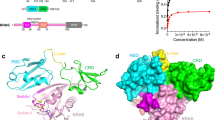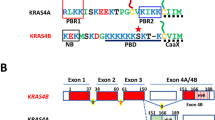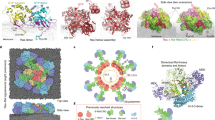Abstract
A CONSERVED tyrosine kinase-activated signal transduction pathway has recently been identified that comprises the plasma membrane-bound small guanine-nucleotide-binding protein Ras and the protein kinases Raf, MAP-kinase kinase and MAP kinase1,2. GTP-bound Ras interacts directly with the amino-terminal regulatory domain of Raf3–8, but although Ras and Raf can be coimmunoprecipitated from ligand-stimulated cells9,10, Ras-GTP does not stimulate the kinase activity of Raf in vitro6. Furthermore, we have failed to detect Ras in preparations of active detergent-solubilized Raf, demonstrating that once it is activated, Raf does not require Ras. Whereas Raf is normally cytosolic, in cells expressing active Ras, Raf is associated with the plasma membrane. This led us to investigate whether Ras is required to localize Raf to the plasma membrane in order for Raf to become activated. We fused the membrane localization signal of K-Ras(4B) to the carboxy terminus of Raf. This protein is constitutively active and can be further activated by epidermal growth factor, independently of Ras. Our results indicate that Ras functions as a regulated, membrane-bound anchor for Raf, and that other signal(s) also contribute to Raf activation.
This is a preview of subscription content, access via your institution
Access options
Subscribe to this journal
Receive 51 print issues and online access
$199.00 per year
only $3.90 per issue
Buy this article
- Purchase on Springer Link
- Instant access to full article PDF
Prices may be subject to local taxes which are calculated during checkout
Similar content being viewed by others
References
Marshall, C. J. Curr. Opin. Gen. Dev. 4, 82–89 (1994).
Dickson, B. & Hafen, E. Curr. Opin. Gen. Dev. 4, 64–70 (1994).
Van Aelst, L., Barr, M., Marcus, S., Polverino, A. & Wigler, M. Proc. natn. Acad. Sci. U.S.A. 90, 6213–6217 (1993).
Votjek, A. B., Hollenberg, S. M. & Cooper, J. A. Cell 74, 205–214 (1993).
Warne, P. H., Rodriguez Viciana, P. & Downward, J. Nature 364, 352–355 (1993).
Zhang, X.-f et al. Nature 364, 308–313 (1993).
Moodie, S. A., Willumsen, B. M., Weber, M. J. & Wolfman, A. Science 260, 1658–1661 (1993).
Koide, H., Satoh, T., Nakafuku, M. & Kaziro, Y. Proc. natn. Acad. Sci. U.S.A. 90, 8683–8686 (1993).
Finney, R. E., Robbins, S. M. & Bishop, J. M. Curr. Biol. 3, 805–811 (1993).
Hallberg, B., Rayter, S. I. & Downward, J. J. biol. Chem. 269, 3913–3916 (1994).
Evan, G. I., Lewis, G. K., Ramsay, G. & Bishop, J. M. Molec. cell. Biol. 5, 3610–3616 (1985).
Schultz, A. M., Copeland, T. D., Mark, G. E., Rapp, U. R. & Oroszlan, S. Virology 146, 78–89 (1985).
Force, T. et al. Proc. natn. acad. Sci. U.S.A. 91, 1270–1274 (1994).
Traverse, S. et al. Oncogene 8, 3175–3181 (1993).
Hancock, J. F., Magee, A. I., Childs, J. E. & Marshall, C. J. Cell 57, 1167–1177 (1989).
Hancock, J. F., Paterson, H. & Marshall, C. J. Cell 63, 133–139 (1990).
Leevers, S. J. & Marshall, C. J. EMBO J. 11, 569–574 (1992).
Bruder, J. T., Heidecker, G. & Rapp, U. Genes Dev. 6, 545–556 (1992).
Feig, L. A. & Cooper, G. M. Molec. cell. Biol. 8, 3235–3243 (1988).
Williams, N. G., Roberts, T. M. & Li, P. Proc. natn. Acad. Sci. U.S.A. 89, 2922–2826 (1992).
Fabian, J. R., Daar, I. O. & Morrison, D. K. Molec. cell. Biol. 13, 7170–7179 (1993).
Sözeri, O. et al. Oncogene 7, 2259–2262 (1992).
Kolch, W. et al. Nature 364, 249–252 (1993).
Gómez, N. & Cohen, P. Nature 353, 170–173 (1991).
Howe, L. R. et al. Cell 71, 335–342 (1992).
Stokoe, D. et al. EMBO J. 11, 3985–3994 (1992).
Alessi, D. R. et al. EMBO J. 13, 1610–1619 (1994).
Furth, M. E., Davis, L. J., Fleurdelys, B. & Scolnick, E. M. J. Virol. 43, 294–304 (1982).
Schaap, D., van der Wal, J., Howe, L. R., Marshall, C. J. & van Blitterswijk, W. J. J. biol. Chem. 268, 20232–20236 (1993).
Author information
Authors and Affiliations
Rights and permissions
About this article
Cite this article
Leevers, S., Paterson, H. & Marshall, C. Requirement for Ras in Raf activation is overcome by targeting Raf to the plasma membrane. Nature 369, 411–414 (1994). https://doi.org/10.1038/369411a0
Received:
Accepted:
Issue Date:
DOI: https://doi.org/10.1038/369411a0
This article is cited by
-
The role of CRAF in cancer progression: from molecular mechanisms to precision therapies
Nature Reviews Cancer (2024)
-
Targeting the RAS/RAF/MAPK pathway for cancer therapy: from mechanism to clinical studies
Signal Transduction and Targeted Therapy (2023)
-
Identification of cis-acting determinants mediating the unconventional secretion of tau
Scientific Reports (2021)
-
K15 promoter-driven enforced expression of NKIRAS exhibits tumor suppressive activity against the development of DMBA/TPA-induced skin tumors
Scientific Reports (2021)
-
Identification and characterization of a BRAF fusion oncoprotein with retained autoinhibitory domains
Oncogene (2020)
Comments
By submitting a comment you agree to abide by our Terms and Community Guidelines. If you find something abusive or that does not comply with our terms or guidelines please flag it as inappropriate.



